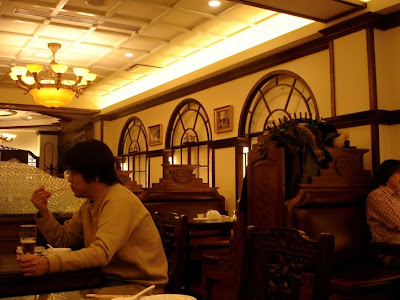Chinese restaurants in Yokohama's chuukagai (chinatown) are oh-so-dramatic. The Japanese regards Chinese cuisine as exquisite and exotic, and to some, a curiosity. I always get the feeling that the Japanese truly understand and appreciate the thousand-year old tradition of Chinese cuisine, and this is reflected by the many Chinese chefs that are elevated to celebrity status (complete with all the polishings and regalia - such as dramatic silk uniforms, 'legendary' knives, and their own TV shows). If you're a fan of ryouri no tetsujin (Iron chef), you might get the idea. Anyway, it seems that the Japanese reserve a special place for Chinese cuisine in their heart. Heck, a lot of Japanese food has its origin from Chinese food, after all. Ramen, Gyoza, and Nikuman is just a few of them.
Understandably, Chinese restaurants in Yokohama are decorated with all types of Chinese stereotypical symbols and decorations you can think of, all thrown together. (Think dragons, red lanterns, and dramatic temple-esque roofs). It's all so fancy.
Menu-wise, most Chinese food served in this largest Chinatown in Asia is what we call a Chinese-Japanese cuisine. Only a handful of the hundreds of restaurants lining up the area serve authentic Chinese cuisine. The rest serve a modification of Chinese cuisine to Japanese tastebuds. Popular dishes (available in most restaurants) are the likes of subuta (sweet and sour pork), mapo-dofu (tofu cooked with minced meat), chahan (fried rice), and of course, ramen, dimsum, and nikuman (meat bun).
Having no previous knowledge of which restaurants are good, I decided to follow the old trick of choosing the one with the longest queue. However, it was 3 pm when I was there, so there were no queues anywhere. So, I chose a restaurant randomly.
This restaurant, Jo gen ro, serves Chinese restaurant in a 1930's Shanghai bar atmosphere. It's a nice place, even though I was a little put off by their choice of music playing on the sound system. It was Twelve Girls Band's rendition of SMAP's "sekai ni hitotsu dake no hana".
For Japanese, what a typical choice, I must say.

Gomoku ankake tsuyu soba
The name is roughly translated as "thick soy-sauce gomoku noodles". Don't ask me what does gomoku means. It actually means somewhere in the line of "five times / fifth", but don't ask me why. It's just a name, probably. Anyway, this dish is quite good. However, I would say for Indonesians (like me), it somehow fails to impress me because it tastes somewhat like "mie cap cay", a common Chinese-Indonesian dish of a very similar taste and consistency.

Iced Oolong Tea
-> Now what's a trip to a Chinese restaurant in Japan without ordering a staple drink of Chinese restaurants, the Oolong tea. Oolong is Japan's favorite Chinese tea, and it goes with any Chinese dish beautifully.
Trivia: From what I've noticed, the Japanese is very strict on the amount of drink poured into a glass. The liquid should always be filled until about 4/5 the height of the glass (as shown above). This law is somewhat universal in Japan, practically every restaurants I went in Japan always fill the drinks to that measurement. To me, that's a tad too little. I don't know why they do that. As a comparison, in Indonesia, for example, drinks in restaurants are always filled almost to the brim (except wines). In Indonesian philosophy, this reflects generosity, as pouring too little drink can be considered stingy, or even rude.











No comments:
Post a Comment